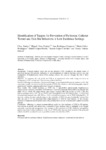Identification of targets for prevention of peritoneal catheter tunnel and exit-site infections in low incidence settings

Ver/Abrir
Use este enlace para citar
http://hdl.handle.net/2183/28121Colecciones
- Investigación (FCS) [1293]
Metadatos
Mostrar el registro completo del ítemTítulo
Identification of targets for prevention of peritoneal catheter tunnel and exit-site infections in low incidence settingsAutor(es)
Fecha
2016-01-01Cita bibliográfica
Santos C, Pérez-Fontán M, Rodríguez-Carmona A, Calvo-Rodríguez M, López-Muñiz A, López-Calviño B, García-Falcón T. Identification of targets for prevention of peritoneal catheter tunnel and exit-site infections in low incidence settings. Perit Dial Int. 2016 Jan-Feb;36(1):43-51.
Resumen
[Abstract] ♦ Background:
Peritoneal catheter tunnel and exit-site infection (TESI) complicates the clinical course of peritoneal dialysis (PD) patients. Adherence to recommendations for catheter insertion, exit-site care, and management of Staphylococcus aureus (SAu) carriage reduces, but does not abrogate the risk of these infections.
♦ Objective:
To reappraise the risk profile for TESI in an experienced center with a long-term focus on management of SAu carriage and a low incidence of these infections.
♦ Method:
Following a retrospective, observational design, we investigated 665 patients incident on PD. The main study variable was survival to the first episode of TESI. We considered selected demographic, clinical, and technical variables, applying multivariate strategies of analysis.
♦ Main results:
The overall incidence of TESI was 1 episode/68.5 patient-months. Staphylococcus aureus carriage disclosed at inception of PD (but not if observed sporadically during follow-up) (hazard ratio [HR] 1.53, p = 0.009), PD started shortly after catheter insertion (HR 0.98 per day, p = 0.011), PD after kidney transplant failure (HR 2.18, p = 0.017), lower hemoglobin levels (HR 0.88 per g/dL, p = 0.013) and fast peritoneal transport rates (HR 2.92, p = 0.03) portended an increased risk of TESI. Delaying PD ≥ 30 days after catheter insertion markedly improved the probability of TESI. Carriage of methicillin-resistant SAu since the start of PD was associated with a high incidence of TESI by these bacteria. On the contrary, resistance to mupirocin did not predict such a risk, probably due to the use of an alternative regime in affected patients.
♦ Conclusions:
Adherence to current recommendations results in a low incidence of TESI in PD patients. Interventions on specific risk subsets have a potential to bring incidence close to negligible levels. Despite systematic screening and management, SAu carriage is still a predictor of TESI. Antibiotic susceptibility patterns may help to refine stratification of the risk of TESI by these bacteria. Early insertion of the peritoneal catheter should be considered whenever possible, to reduce the risk of later TESI.
Palabras clave
Peritoenal dialysis
Peritoneal dialysis
Staphylococcus aureus
Mupirocin
Tunnel and exit-site infection
Peritoneal dialysis
Staphylococcus aureus
Mupirocin
Tunnel and exit-site infection
Versión del editor
ISSN
0896-8608





